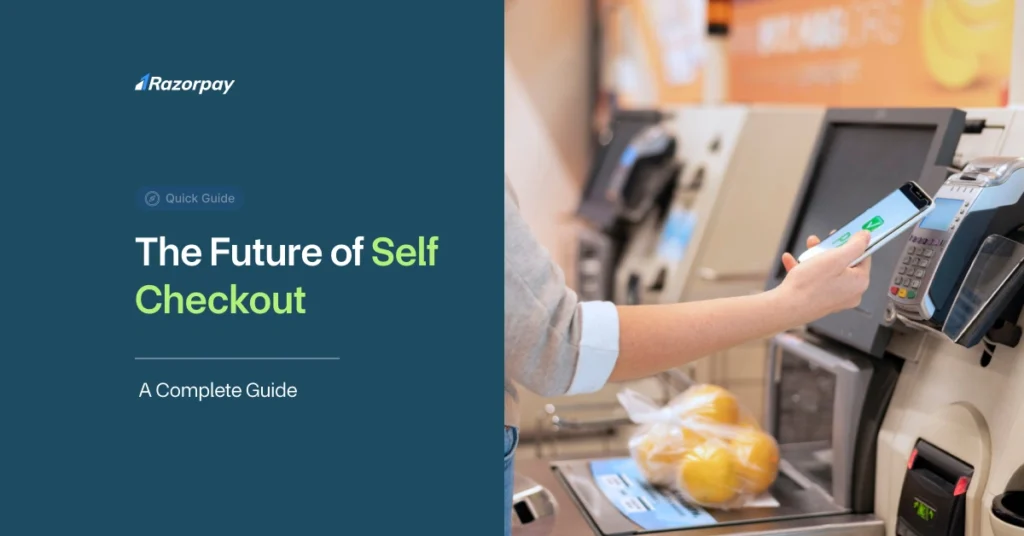Self-checkout technology is rapidly evolving beyond the familiar barcode scanners and kiosks. The future promises AI-driven systems and cashier-less shopping experiences that make retail faster, smarter, and more seamless than ever before. These innovations focus on integrating cutting-edge tech—such as computer vision, machine learning, and mobile connectivity—directly into the shopping journey, reshaping how customers interact with stores and streamlining retail operations.
In India, this shift is gaining momentum. Leading retailers like DMart and food service giants such as McDonald’s India are already experimenting with self-checkout solutions to reduce wait times and enhance customer convenience. These early adopters reflect a growing trend where Indian businesses are embracing automation, aiming to blend technology with the unique preferences of Indian consumers.
Table of Contents
The Growth of Self Checkout
Self-checkout has transformed from a niche convenience feature to a mainstream retail staple worldwide. Today, it spans from supermarkets to large-format stores and quick-service restaurants (QSRs). Technologies such as mobile scan-and-go apps and self-ordering kiosks have become increasingly common in global chains, offering customers faster, contactless service.
In India, this evolution is well underway. For instance:
- Decathlon’s large stores feature self-checkout stations that help speed up billing.
- McDonald’s India has deployed touchscreen self-ordering kiosks in metro cities to cut down wait times and improve order accuracy.
Supporting this transformation, solutions like Razorpay POS enable Indian retailers and QSRs to adopt a seamless digital checkout process that accepts multiple payment mode,s including UPI, credit/debit cards, and mobile wallets, making payments smoother for both merchants and customers.
Self-checkout isn’t a new idea—it dates back to 1986. However, the wave of digitization during the Covid-19 pandemic gave it a major boost, making it a game-changer in retail and food service. The future of self-checkout is now shaped by several key drivers: labour shortages, growing consumer demand for speed and convenience, and the increasing comfort with digital payments.
A recent survey by SOTI found that over 60% of shoppers prefer using self-service technology instead of asking a salesperson for help. This shift highlights how consumers are embracing self-checkout as part of their shopping experience.
According to data cited on knowledge-sourcing.com, the self-checkout systems market was valued at $11.04 billion in 2020 and is expected to skyrocket to $38.3 billion by 2027, growing at an impressive CAGR of 19.44%. This rapid growth underscores why the future of self checkout is not just promising but inevitable.
Self-Checkout: Pros, Cons, and Its Overall Impact
A Business Point of View
Self-checkout technology offers several clear benefits for businesses:
- It helps reduce labor costs by requiring fewer cashiers on the floor.
- These systems gather valuable customer data, allowing for improved marketing strategies.
- Real-time purchase tracking enhances inventory management and helps avoid overstocking or stockouts.
However, businesses also face some challenges:
- The initial investment for kiosks and related infrastructure can be expensive.
- Theft prevention demands strong security measures such as AI-powered cameras, weight sensors, and staff supervision to reduce shrinkage.
In India, Razorpay POS supports self-checkout kiosks and assisted billing counters, enabling real-time payment processing that streamlines operations and enhances the customer experience in retail and QSR sectors.
The Consumer Experience
Consumers enjoy:
- Faster, more independent shopping by skipping long queues.
- The flexibility to shop at their own pace.
Challenges consumers might face include:
- Technical glitches or scanning errors.
- Difficulties with bagging items properly.
For self-checkout to succeed, retailers must ensure the technology is reliable and easy to use, balancing convenience with a smooth, hassle-free experience to maintain customer satisfaction.
Impact on Employee
The rise of self-checkout systems has raised concerns about potential job losses, particularly in cashier roles. As more tasks become automated, the nature of retail work is changing.
However, this shift also opens up new opportunities:
- Employees can transition into tech support, system monitoring, or customer assistance roles.
- There’s a growing need for staff who can handle backend maintenance, troubleshoot issues, and ensure the smooth functioning of self-checkout systems.
To manage this change effectively, many businesses are investing in retraining and upskilling programs. These initiatives help existing staff adapt to the evolving retail landscape, ensuring they remain valuable contributors even as technology transforms their roles.
Where Self-Checkout Is Going: Predictions and Ongoing Debates
Advances in Technology
The future of self-checkout is closely tied to rapid advancements in technology, particularly AI and sensor-based systems. One promising development is AI-powered image recognition, which can dramatically reduce scanning errors and improve theft prevention by automatically verifying items without manual input. This technology not only speeds up checkout but also enhances accuracy, building consumer trust.
Another exciting innovation involves sensor-based environments. In these setups, sensors track items as customers pick them up and automatically charge their accounts when they leave the store—eliminating the need for any scanning or payment interaction at the counter. Retail giants and startups alike are experimenting with such cashier-less models, which could redefine the self-checkout experience entirely.
Differences in Retail vs. Food Service
Self-checkout adoption varies significantly between the retail and food service sectors. Grocery stores and large-format retailers lead the way due to high volume, repetitive transactions, and consumer demand for speed and convenience. For example, Indian retailers like DMart and Decathlon have successfully integrated self-checkout stations, supported by payment platforms like Razorpay POS that accommodate multiple payment modes including UPI, cards, and wallets.
On the other hand, sit-down restaurants and full-service food outlets remain cautious. Customers in these environments often expect personalized service and interaction, which are harder to replicate through technology. Quick-service restaurants (QSRs) such as McDonald’s India are experimenting with touchscreen self-order kiosks to strike a balance—speeding up orders while still maintaining some human assistance.
Balancing the Human Touch
While self-checkout technology is transforming the retail landscape, maintaining the human element remains crucial. Many customers still value the personal interaction and assistance that only a human employee can provide, especially in complex transactions or when problems arise.
Hybrid models, where technology supports but does not fully replace human roles, are becoming increasingly popular. In such setups, self-checkout kiosks handle straightforward transactions, while staff focus on customer service, troubleshooting, and creating a welcoming environment. This balance helps businesses improve efficiency without sacrificing the quality of the customer experience.
The Ethical Debate
The rise of self-checkout also raises important ethical questions about the fair distribution of automation’s benefits. As automation replaces some jobs, businesses must ensure that workers are not left behind.
Key strategies include:
- Investing in retraining and upskilling programs to prepare employees for new roles in tech support, system maintenance, and customer assistance.
- Emphasizing ethical practices that promote workforce inclusion and digital accessibility.
- Creating policies that balance automation with social responsibility to support employees through the transition.
Sustainability and Future Challenges
Self-checkout technology is reshaping the retail and food service landscapes, offering speed and convenience that customers increasingly expect. However, businesses must thoughtfully balance adopting new technologies with maintaining meaningful customer connections.
Long-term success depends on finding the right mix of automation and human interaction. Over-reliance on technology risks alienating customers who still value personal service, while too little automation can slow down operations and increase costs.
Some of the future challenges businesses will face include:
- Integrating self-checkout systems without disrupting the customer experience.
- Addressing digital accessibility so that all customers, including those less tech-savvy, feel comfortable using these systems.
- Ensuring employee roles evolve to complement technology rather than compete with it.
By investing in hybrid models and continuous employee training, businesses can overcome these obstacles, achieving sustainable growth while keeping customer satisfaction high.
Ready to Take Your Checkout Experience to the Next Level?
Whether you’re just starting with self-checkout or optimizing your current setup, Razorpay POS offers a modern, easy-to-use payment solution tailored specifically for Indian retailers and food service businesses.
Streamline your payments, reduce customer wait times, and enhance the overall checkout experience with a platform built to support multiple payment methods including UPI, cards, and wallets.
Explore how Razorpay POS can help you deliver seamless, secure, and scalable checkout solutions. Get started today and delight your customers with faster, smarter payments.
Frequently Asked Questions (FAQs)
1. Is self-checkout the future of retail and food service?
Yes, self-checkout is becoming a key part of the future, especially in sectors like grocery retail and quick-service restaurants. Its growth is driven by consumer demand for speed and convenience and advances in AI and automation technologies.
2. What are the main challenges or downsides of self-checkout?
Challenges include the high initial investment cost, potential job displacement, technical glitches, and the risk of theft. Additionally, maintaining a smooth customer experience requires balancing technology with human assistance.
3. What are the current trends in self-checkout adoption?
Current trends include AI-based image recognition, sensor-enabled cashier-less stores, mobile scan-and-go options, and touchscreen kiosks. In India, retailers and QSRs like DMart, Decathlon, and McDonald’s are adopting these technologies, supported by platforms like Razorpay POS for seamless payments.
4. Will self-checkout lead to job losses in retail?
While self-checkout can reduce traditional cashier roles, it also creates new jobs in technical support, system maintenance, and customer assistance. Businesses focusing on retraining and upskilling employees can ensure a smooth workforce transition.

